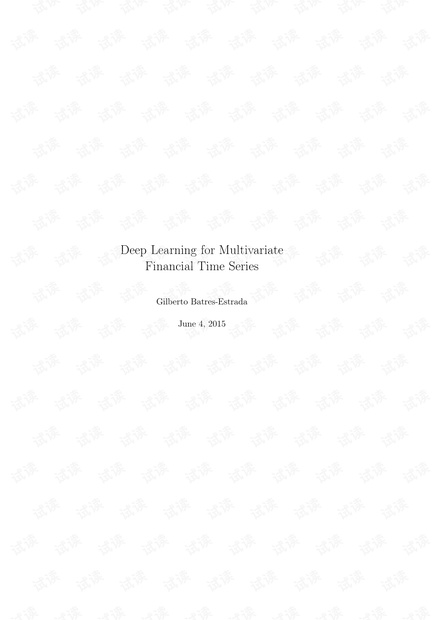没有合适的资源?快使用搜索试试~ 我知道了~
首页Deep Learning for Multivariate Financial Time Series
资源详情
资源评论
资源推荐

Deep Learning for Multivariate
Financial Time Series
Gilberto Batres-Estrada
June 4, 2015


Abstract
Deep learning is a framework for training and modelling neural networks
which recently have surpassed all conventional methods in many learning
tasks, prominently image and voice recognition.
This thesis uses deep learning algorithms to forecast financial data. The
deep learning framework is used to train a neural network. The deep neural
network is a DBN coupled to a MLP. It is used to choose stocks to form
portfolios. The portfolios have better returns than the median of the stocks
forming the list. The stocks forming the S&P 500 are included in the study.
The results obtained from the deep neural network are compared to bench-
marks from a logistic regression network, a multilayer perceptron and a naive
benchmark. The results obtained from the deep neural network are better
and more stable than the benchmarks. The findings support that deep learn-
ing methods will find their way in finance due to their reliability and good
performance.
Keywords: Back-Propagation Algorithm, Neural networks, Deep Belief Net-
works, Multilayer Perceptron, Deep Learning, Contrastive Divergence, Greedy
Layer-wise Pre-training.

Acknowledgements
I would like to thank Söderberg & Partners, my supervisor Peng Zhou at
Söderberg & Partners, my supervisor Jonas Hallgren and examiner Filip
Lindskog at KTH Royal Institute of Technology for their support and guid-
ance during the course of this interesting project.
Stockholm, May 2015
Gilberto Batres-Estrada
iv

Contents
1 Introduction 1
1.1 Background . . . . . . . . . . . . . . . . . . . . . . . . . . . . 2
1.2 Literature Survey . . . . . . . . . . . . . . . . . . . . . . . . . 2
2 Neural Networks 5
2.1 Single Layer Neural Network . . . . . . . . . . . . . . . . . . 6
2.1.1 Artificial Neurons . . . . . . . . . . . . . . . . . . . . . 6
2.1.2 Activation Function . . . . . . . . . . . . . . . . . . . 7
2.1.3 Single-Layer Feedforward Networks . . . . . . . . . . . 11
2.1.4 The Perceptron . . . . . . . . . . . . . . . . . . . . . . 12
2.1.5 The Perceptron As a Classifier . . . . . . . . . . . . . 12
2.2 Multilayer Neural Networks . . . . . . . . . . . . . . . . . . . 15
2.2.1 The Multilayer Perceptron . . . . . . . . . . . . . . . . 15
2.2.2 Function Approximation with MLP . . . . . . . . . . . 16
2.2.3 Regression and Classification . . . . . . . . . . . . . . 17
2.2.4 Deep Architectures . . . . . . . . . . . . . . . . . . . . 18
2.3 Deep Belief Networks . . . . . . . . . . . . . . . . . . . . . . . 22
2.3.1 Boltzmann Machines . . . . . . . . . . . . . . . . . . . 22
2.3.2 Restricted Boltzmann Machines . . . . . . . . . . . . . 24
2.3.3 Deep Belief Networks . . . . . . . . . . . . . . . . . . . 25
2.3.4 Model for Financial Application . . . . . . . . . . . . . 27
3 Training Neural Networks 31
3.1 Back-Propagation Algorithm . . . . . . . . . . . . . . . . . . 31
3.1.1 Steepest Descent . . . . . . . . . . . . . . . . . . . . . 31
3.1.2 The Delta Rule . . . . . . . . . . . . . . . . . . . . . . 32
Case 1 Output Layer . . . . . . . . . . . . . . . . . . . 33
Case 2 Hidden Layer . . . . . . . . . . . . . . . . . . . 33
Summary . . . . . . . . . . . . . . . . . . . . . . . . . 33
3.1.3 Forward and Backward Phase . . . . . . . . . . . . . . 34
Forward Phase . . . . . . . . . . . . . . . . . . . . . . 34
Backward Phase . . . . . . . . . . . . . . . . . . . . . 34
3.1.4 Computation of δ for Known Activation Functions . . 35
v
剩余93页未读,继续阅读

绝不原创的飞龙
- 粉丝: 1w+
- 资源: 1091
上传资源 快速赚钱
 我的内容管理
收起
我的内容管理
收起
 我的资源
快来上传第一个资源
我的资源
快来上传第一个资源
 我的收益 登录查看自己的收益
我的收益 登录查看自己的收益 我的积分
登录查看自己的积分
我的积分
登录查看自己的积分
 我的C币
登录后查看C币余额
我的C币
登录后查看C币余额
 我的收藏
我的收藏  我的下载
我的下载  下载帮助
下载帮助

会员权益专享
最新资源
- 2023年中国辣条食品行业创新及消费需求洞察报告.pptx
- 2023年半导体行业20强品牌.pptx
- 2023年全球电力行业评论.pptx
- 2023年全球网络安全现状-劳动力资源和网络运营的全球发展新态势.pptx
- 毕业设计-基于单片机的液体密度检测系统设计.doc
- 家用清扫机器人设计.doc
- 基于VB+数据库SQL的教师信息管理系统设计与实现 计算机专业设计范文模板参考资料.pdf
- 官塘驿林场林防火(资源监管)“空天地人”四位一体监测系统方案.doc
- 基于专利语义表征的技术预见方法及其应用.docx
- 浅谈电子商务的现状及发展趋势学习总结.doc
- 基于单片机的智能仓库温湿度控制系统 (2).pdf
- 基于SSM框架知识产权管理系统 (2).pdf
- 9年终工作总结新年计划PPT模板.pptx
- Hytera海能达CH04L01 说明书.pdf
- 数据中心运维操作标准及流程.pdf
- 报告模板 -成本分析与报告培训之三.pptx
资源上传下载、课程学习等过程中有任何疑问或建议,欢迎提出宝贵意见哦~我们会及时处理!
点击此处反馈



安全验证
文档复制为VIP权益,开通VIP直接复制
 信息提交成功
信息提交成功
评论0